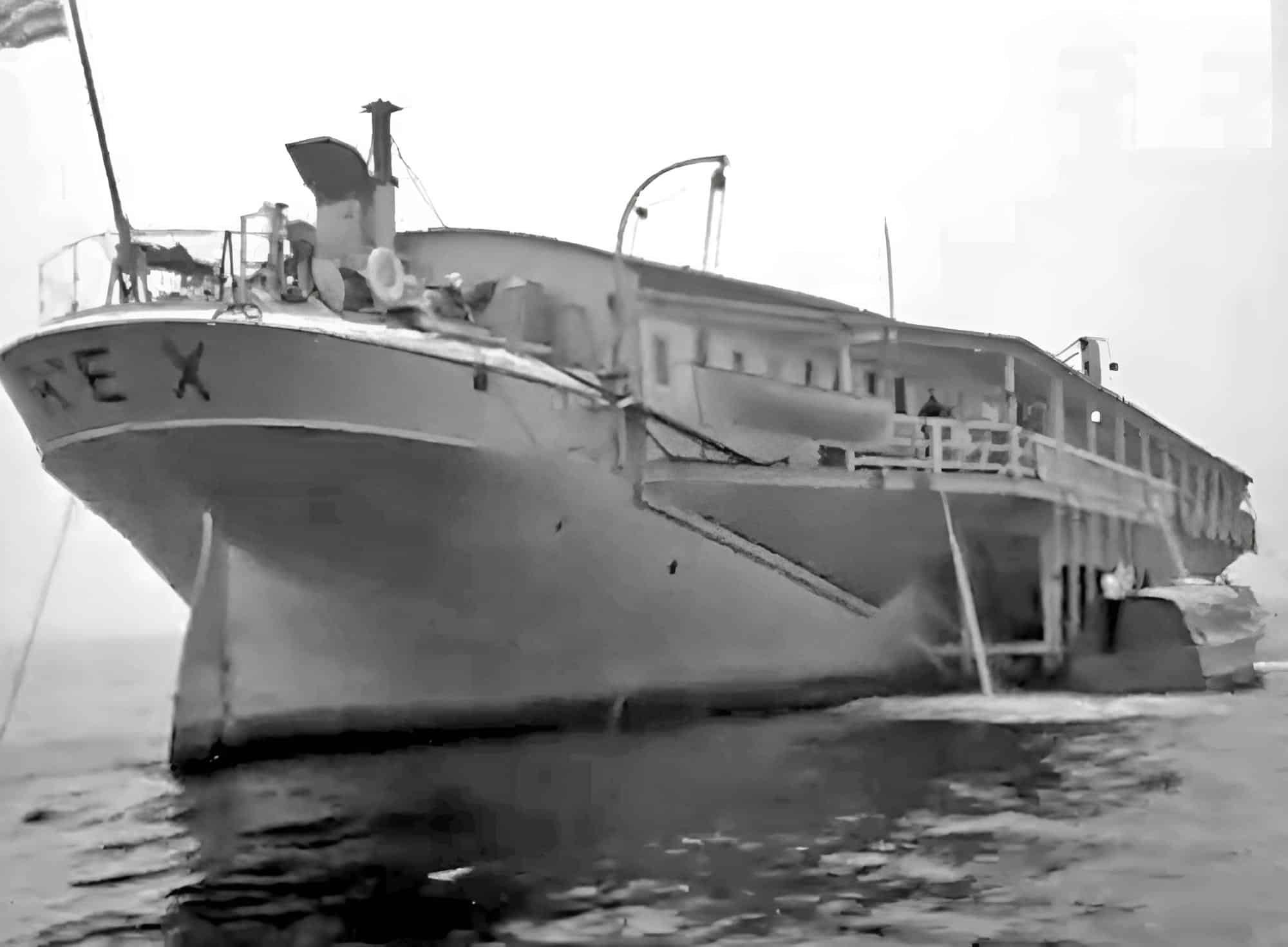Ship details: There were around a dozen “gambling ships” operating throughout the 1930’s, but the one that stood out above the others was Tony Cornero’s S.S. Rex. Cornero had been involved with several other boats, most notably the S.S. Tango (which he lost in a crap game) but the Rex was his baby.
The Rex was launched in 1887 as the Kenilworth, a grain ship. In 1903, it was rechristened the Star of Scotland and served as a floating cannery in Alaska. By 1930, the boat was used to transport people in style between Santa Catalina and Los Angeles. When Cornero came across her, she was a live bait barge in the Santa Monica bay. Fishermen in boats would come up and buy bait to continue fishing.
Cornero bought the barge, totally remodeled it, and opened on May 5, 1938 as the S.S. Rex. Cornero’s investment, rumored to be $600,000, was financed by Bugsy Siegal and George Raft. He towed his boat exactly 3.1 miles offshore, and announced by radio and newspaper advertisements that he was open for business. He offered a challenge, a $100,000 reward to anyone who could show that any game on the Rex was rigged. The boat could hold 2,000 people and had a staff of 325 daily. There was an orchestra and dance floor, great chefs working in the full size kitchen, and of course, a grand casino. There were over 100 slot machines to keep the wives and girlfriends happy, a 400 seat bingo parlor, and a horse book that got race results via shortwave radio.
It was a first class operation with good food, top name dance bands, unwatered booze and honest games. Gamblers had a choice of playing craps, roulette, blackjack, chuck-a-luck, high spade, wheel of fortune, Chinese lottery, stud poker and faro. There were Tango layouts between decks and 150 “one armed bandits” lined the casino walls. The operation was a success and netted Tony $300,000 per month.
More than 2500 daily made the trip out to the Rex, and would line up at the end of Santa Monica pier to catch motor launches that took them out to the boat.
The Rex and the other gambling boats were a thorn in the side of anti-gambling forces. The local authorities could do nothing because they operated just beyond their jurisdiction. Police often harassed the water taxi service, but their efforts were struck down in court. Finally California Attorney General Earl Warren decided to take action. He armed himself with nuisance abatement warrants and went after the gambling fleet.
He had no difficulty shutting down two boats in Long Beach and the Texas off Venice, but the Rex didn’t give in easily. Cornero got wind of the operation when seventeen unarmed plainclothes officers tried to sneak aboard the ship with the other customers. Bouncers spotted them easily and escorted them off the ship.
Warren rounded up a flotilla of State and Game boats, manned them with deputies and ordered them out to the Rex. Cornero was ready and repelled the invasion with high pressure hoses. The authorities laid siege for nine tense days while Cornero’s men stood guard with sub-machine guns. His attorneys filed suit after suit charging Warren with everything from harassment to piracy.
Then Tony Cornero unexpectedly surrendered on August 9, 1938. The war moved to the courts. The high court finally ruled a year later that the three mile limit in the Santa Monica Bay extended from an imaginary line connecting Point Dume to Point Vicente. Tony had to pay fines and court costs. By late 1939, all boats had successfully been closed down. The Rex was used as a cargo barge by the U.S. Navy during World War II.
Offshore radio station: A commercial radio station for Santa Monica is reported to have broadcast from the S.S. Rex in 1938/39.
Paul Rusling writing: “During the years of prohibition, organised crime syndicates in the USA realised that operating on boats located just outside territorial waters was a great way to get round many laws, particularly the lucrative vices of gambling and drinking. Offshore casinos with licensed bars popped up off California and to promote their services they established radio stations on board.
Among the biggest of the ships were the City of Panama, which broadcast its own station on 815kHz AM, and a ship called Rex. They were run by mobster Tony Cornero and financed by Bugsy Siegal, a legendary underworld figure at the time. They spent over $1m US to equip and float their ships, whose radio signals could be heard all along the western seaboard of the USA, attracting business to the ship. With a staff of 300 it could hold over 2000 customers, so clearly the offshore gambling boats were a big business. Without the radio stations on board them, it’s doubtful they could have attracted enough business.”
Location: International waters off Santa Monica, California

